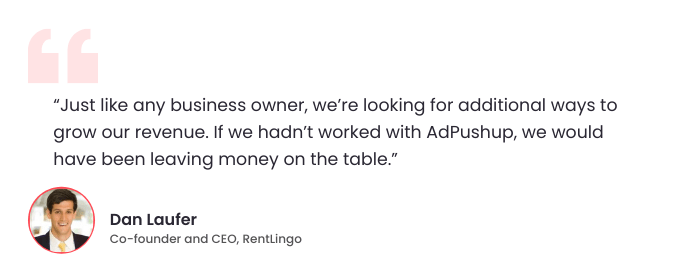This detailed comparison lets you delve deeper into the nuances of instream vs outstream ads and understand their distinctions and make informed advertising choices
We all stream videos, whether on YouTube or other streaming platforms. And, while we do that, some ads come in and interrupt everything.
Well, those ads are known as in-stream video ads. Instream ads are video ads that play during, before, or after a piece of video. They’re a common way for businesses to reach their target audience and have proven to be an effective ad type.
In recent data by HubSpot, it came out that almost 43% of consumers do click on instream ads, which makes them a go-to online ad channel.
However, the advertising landscape has seen a shift towards outstream video ads too. Outstream ads are video ads that appear outside of a video player. They can be embedded in various places, such as in a website’s sidebar, social media feed, or mobile app.
Outstream ads are another equally effective ad type, and they are generally less disruptive to the user experience compared to instream ads.
With this brief introduction to both in-stream and out-stream ads, let’s take a closer look at them in this blog post, giving each their due recognition and examining their types and effectiveness.
What are Instream Video Ads?
In-stream video ads have emerged as a prominent and influential means of reaching target audiences. Positioned within video content, these ads flawlessly integrate into the user experience, capturing viewers’ attention as they engage with online videos.
Instream ads come in various video ad types, each catering to specific placement and engagement strategies. Here are some of them:
Linear Ads
Linear instream ads play during, before, or after the main video content. These ads interrupt the video playback, resembling traditional TV commercials. They can be further categorized into:
Pre-Roll Ads
These ads appear prior to the video content and are typically short. They set the stage for the experience of the viewer.
Mid-Roll Ads
Mid-roll ads are inserted during a video, interrupting the content at strategic points. They can provide a break in longer videos.
Post-Roll Ads
These ads play after the main video concludes, allowing advertisers to leave a long-lasting and strong impression on viewers.
Non-Linear Ads
Non-linear instream ads appear over or beside the main video content without interrupting the playback.
They often enhance the experience of the viewer by providing interactive elements or additional information. Common types of non-linear ads include overlay banners, text ads, and interactive buttons.

Companion Ads
Companion ads, or display ads, accompany the main video content.
These ads appear alongside the video player, allowing advertisers to showcase complementary messaging. They can include images, text, or other multimedia elements.
What Are the Advantages of Instream Ads?
There are a number of benefits that make in-stream video advertising appealing to marketers who want to successfully engage their target audience.
High Engagement
Instream ads benefit from flawlessly integrating into the video content, increasing the likelihood of capturing viewers’ attention and engagement.
Captive Audience
As viewers are invested in the video content, instream ads have a better chance of being noticed and retained.
Visual Impact
Video is a dynamic medium that allows advertisers to convey their message through sight, sound, and motion, leading to a more substantial impact on viewers.
Targeted Reach
Instream ads can target specific demographics and interests, ensuring the right audience sees the message.
What Are the Limitations of Instream Ads?
While there are many advantages to using in-stream video advertising, there are also certain drawbacks that marketers should be aware of.
Ad Fatigue
Repeated exposure to instream ads can significantly lead to viewer fatigue and ad avoidance if the ads interrupt the content too frequently.
Viewer Resistance
Some viewers may find instream ads intrusive, particularly when they disrupt their video-watching experience.
Ad Blockers
Ad-blocking software can prevent instream ads from being displayed to users who have enabled these tools.
Outstream Video Ads: What are they?
Outstream video ads have gained prominence as an innovative way to engage audiences beyond the confines of traditional video content.
Unlike instream ads embedded within existing videos, out-stream ads live independently of video content.
They make it possible for marketers to contact their intended audience in a variety of settings and mediums. Some of the more important kinds, along with their distinguishing traits, are as follows:
In-Slide Ads
Ads that slide in and out of the screen as the user scrolls are called in-stream or in-slide.
They typically appear as a video player that expands or slides out from a designated position on the webpage. This format captures the viewer’s attention without interrupting their interaction with the site’s content.
In-Content Ads
Blog entries, essays, and other forms of written material may have in-content, out-stream advertisements. These advertisements begin playing automatically when the user scrolls down to them, giving the impression that they are part of the text itself.
This format enables marketers to interact with consumers in a setting that is very relevant to them.
In-Banner Ads
In-banner out-stream ads combine video content with traditional display ad formats. They appear as banners with a video player embedded within them.
The banner expands to reveal the video content when clicked or hovered over. This format offers an interactive way to engage viewers within a compact space.
What Are the Advantages of Outstream Ads?
Advertisers looking for a wide variety of interaction options will find that outstream video advertising provides several benefits.
Expanded Reach
Outstream ads can appear on various platforms, such as websites, social media feeds, and mobile apps, increasing their visibility to a broader audience.
Non-Intrusive Experience
Since out-stream ads play outside of video content, they offer a non-disruptive experience that users can engage with voluntarily.
Increased Viewability
Outstream ads often have higher ad viewability rates, as they only play when visible on the screen, contributing to better engagement metrics.
What Are the Limitations of Outstream Ads?
Despite their advantages, out-stream video ads also come with certain limitations to consider:
Lower Engagement
Outstream ads may have lower engagement rates than instream ads, as they rely on user interaction and voluntary engagement.
Dependent on User Interaction
The success of out-stream ads often relies on users actively interacting with the ad by clicking, hovering, or expanding it.
Contextual Integration
Poorly integrated out-stream ads might disrupt the user experience, especially if they feel they need to be put in the surrounding content.
How Do InStream Ads and Out-Stream Ads Differ from Other Ads?
In-stream and out-stream video ads represent a dynamic shift in how advertisers engage with their target audience.
These ad formats offer distinct advantages and depart from traditional advertising methods.
Here’s how in-stream and out-stream ads differ from other types of ads:
Instream Ads vs. Display Ads
Instream ads differ significantly from traditional display ads, which are static visuals placed within webpage content.
While display ads rely on eye-catching visuals and concise text to convey their message, instream ads leverage the power of video to capture viewer attention through sight, sound, and motion.
Instream ads can evoke emotions and tell a more immersive story, enhancing the overall impact of the advertising message.
Outstream Ads vs. Banner Ads
Outstream ads stand apart from traditional banner ads in their engagement approach. Banner ads are typically static visuals on web pages and require users to click for more information.
Outstream ads, on the other hand, involve video content that can play automatically, encouraging passive viewers to become active participants in the ad experience.
Incorporating the video within the banner format creates a more interactive and engaging user journey.
Instream and Outstream Ads vs. Native Ads
Both in-stream and out-stream ads share similarities with native advertising, which seamlessly blends in with the surrounding content to provide a non-disruptive user experience.
Video is only one kind of native marketing; others include sponsored posts on social media and suggested reading.
In-stream and out-stream ads focus specifically on video content and its integration within various platforms.
Instream and Outstream Ads vs. Social Media Ads
Social media feed advertising is different from in-stream and out-of-stream video ads.
Promotions shared on social media platforms may use either still images or moving pictures.
Social media advertising frequently emphasizes engagement via likes, comments, shares, and conversations with the brand’s social media community, in contrast to in-stream and out-stream commercials which concentrate on video storytelling.
An In-Depth Comparison Between Instream vs Outstream Video Ads
User Experience When It Comes to Instream vs Outstream Video Ads
InStream Ads
Instream ads provide a captive audience by leveraging the viewer’s interest in the main video content. However, they can sometimes be perceived as intrusive if they interrupt the viewing experience too frequently.
Outstream Ads
Outstream ads offer a less intrusive experience, playing outside video content and allowing users to engage voluntarily. This can lead to higher viewer satisfaction and more positive brand perception.
Placement of Ads and Integration When It Comes to Instream vs Outstream Video Ads
Instream Ads
Advertisers may catch viewers’ attention while they’re watching videos with in-stream adverts, which don’t interrupt the viewing experience. They show up at varying intervals, creating a wide range of options for participation.
Outstream Ads
Outstream ads appear in various contexts, such as within articles, alongside social media feeds, or as expanding banners. Their diverse ad placements enable advertisers to reach users on different platforms and engage them with the content they already interact with.
Monetization and Revenue Potential When It Comes to Instream vs Outstream Video Ads
Instream Ads
For content creators and publishers, instream ads generate revenue through video monetization. Advertisers often pay for ad placements, contributing to the revenue stream of content providers.
Outstream Ads
Outstream ads provide an avenue for monetization beyond video content. Websites and publishers can generate revenue by offering ad space within articles or on their platforms, even if they don’t produce video content.
Other Factors When It Comes to Instream vs. Outstream Video Ads
Engagement
Instream ads tend to have higher engagement rates due to their integrated nature within video content. Outstream ads rely more on user interaction, which might result in slightly lower engagement.
Viewability
Outstream ads often have higher viewability rates as they play when they’re on-screen, compared to in-stream advertisements that may be skipped or overlooked.
Message Delivery
Instream ads offer a linear narrative that aligns with the main video content. Outstream ads can be more versatile in messaging and tailored to specific contexts.
Platform Diversity
Outstream ads can reach users across multiple platforms and content types, making them suitable for campaigns with a wide-ranging target audience.
How to Make a Decision Between Instream & Outstream Video Ads?
Choosing between out-stream and in-stream video ads requires careful consideration of your campaign objectives, target audience, and the platforms where you intend to engage users.
Each format has strengths and weaknesses, and the decision should align with your advertising goals.
Here’s a step-by-step guide to making a final decision on instream vs outstream video ads:
Define Your Campaign Goals
Get your advertising plan started by defining your goals. Do you need to increase your customer base, make more sales, or captivate your audience with a gripping narrative? When deciding between formats, it’s important to keep your objectives in mind.
Know Your Audience
Identify your target audience’s preferences and behavior. Do they respond better to immersive video content within main videos (in-stream), or are they more receptive to non-intrusive interactions (out-stream)?
Consider Context
Think about the context in which you want your ad to appear. Instream ads might be a suitable choice if you seek integration with specific video content. Out-stream ads offer versatility if you engage users on various platforms.
User Experience Matters
Evaluate the user experience you want to deliver. Instream ads might provide a higher engagement rate due to their integration within video content, while out-stream ads offer a less disruptive experience.
Engagement vs. Interaction
Determine the level of engagement you’re aiming for. Instream ads lead to more immediate attention, while out-stream ads rely on users’ voluntary interaction.
Platform Strategy
Think about where your target audience spends their time. If your audience is spread across various websites and social media platforms, out-stream ads can help you reach them where they are.
Can Publishers Implement Both Types of Ads?
The flexibility of modern digital advertising allows publishers to harness the benefits of both in-stream and out-stream video ads within their monetization strategies.
Implementing both types of ads can offer a well-rounded approach to engaging audiences and generating revenue.
Let’s take a deeper look at the hybrid approach’s viability and benefits:
Diversified Revenue Streams
Incorporating both in-stream and out-stream ads can help publishers tap into different revenue streams. Instream ads provide revenue through video content, while out-stream ads monetize the ad spaces around articles, within social media feeds, and on various platforms.
Enhanced User Experience
With a hybrid strategy, media companies can meet the needs of a wider range of readers. Users who desire a less disruptive experience may interact with out-stream advertisements, while instream ads are available for those who value continuous viewing.
Targeted Monetization
Different sections of a website or platform might be more suitable for specific ad formats. For instance, video-heavy departments could benefit from instream ads, while article-based cells can integrate out-stream ads seamlessly.
Platform Adaptability
Implementing both ad types allows publishers to adapt their strategy to different platforms. Instream ads are well-suited for video-centric platforms, while out-stream ads can thrive on social media feeds, articles, and mobile apps.
Audience Preferences
Audiences have diverse preferences. Some users might be more engaged by in-stream video content, while others might appreciate the subtlety of out-stream ads. Catering to these preferences can improve user satisfaction.
Effective Campaigns
Specific advertising campaigns benefit more from one ad type than the other. Publishers can strategically choose the format that aligns with a campaign’s goals, maximizing its impact.
Final Thoughts
Navigating the digital ads space involves understanding the nuances of in-stream and out-stream video ads.
When it comes to instream ads, they seamlessly integrate within video content, while out-stream ads provide versatility across various platforms.
Each format offers distinct advantages and considerations, choosing between them a strategic decision based on campaign goals, audience preferences, and user experience.
As the advertising landscape evolves, the ability to leverage the strengths of both in-stream and out-stream ads can lead to more engaging, effective, and successful campaigns.
Frequently Asked Question
In-stream video ads are a kind of internet advertising that plays within the course of a video’s normal playback. It may be linear (interrupting the video) or non-linear (playing over it), and it can be played at any time. To attract viewers’ attention, in-stream advertisements model themselves like the dynamic nature of the main video.
Out-stream video ads are commercials shown on websites in lieu of regular video programming. It may show up in articles, social media feeds, or even banners. When an out-stream ad is inside the user’s field of view, it will play automatically.
The native video refers to content that matches the style and context of the platform, blending seamlessly with the surrounding content. Outstream video ads are a type of native video ad format that exists independently of main video content, playing within various contexts like articles or social media feeds.
Some advantages of using out-of-stream video adverts are:
Non-intrusive: They engage users voluntarily, offering a positive user experience.
Versatile placements: Can appear in various formats, such as in-slide, in-content, or in-banner, reaching users across platforms.
Higher viewability: Often have higher viewability rates since they play when on-screen.
Diversified revenue: Allow publishers to monetize spaces beyond video content.
Platform adaptability: Suitable for social media feeds, articles, and apps, reaching users where they are.

Nidhi Mahajan is a content author with a remarkable talent for ad tech. With a deep understanding of the ad tech industry and a sharp focus on detail, she excels in crafting insightful articles and compelling narratives. Nidhi is dedicated to making the complexities of ad tech more accessible to all through her clear and informative writing.







